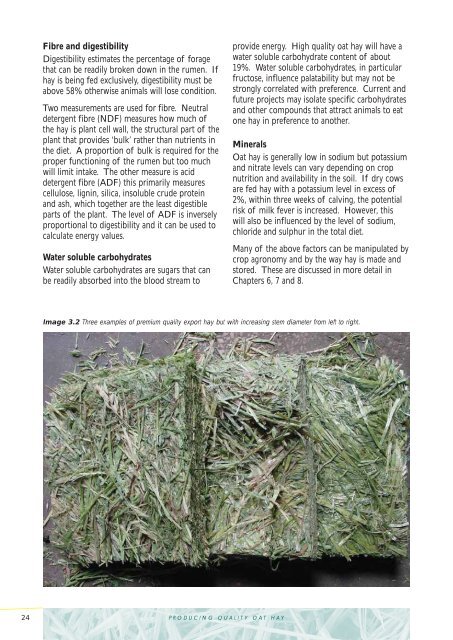You also want an ePaper? Increase the reach of your titles
YUMPU automatically turns print PDFs into web optimized ePapers that Google loves.
Fibre and digestibility<br />
Digestibility estimates the percentage of forage<br />
that can be readily broken down in the rumen. If<br />
hay is being fed exclusively, digestibility must be<br />
above 58% otherwise animals will lose condition.<br />
Two measurements are used for fibre. Neutral<br />
detergent fibre (NDF) measures how much of<br />
the hay is plant cell wall, the structural part of the<br />
plant that provides ‘bulk’ rather than nutrients in<br />
the diet. A proportion of bulk is required for the<br />
proper functioning of the rumen but too much<br />
will limit intake. The other measure is acid<br />
detergent fibre (ADF) this primarily measures<br />
cellulose, lignin, silica, insoluble crude protein<br />
and ash, which together are the least digestible<br />
parts of the plant. The level of ADF is inversely<br />
proportional to digestibility and it can be used to<br />
calculate energy values.<br />
Water soluble carbohydrates<br />
Water soluble carbohydrates are sugars that can<br />
be readily absorbed into the blood stream to<br />
24 PRODUCING QUALITY OAT HAY<br />
provide energy. High quality oat hay will have a<br />
water soluble carbohydrate content of about<br />
19%. Water soluble carbohydrates, in particular<br />
fructose, influence palatability but may not be<br />
strongly correlated with preference. Current and<br />
future projects may isolate specific carbohydrates<br />
and other compounds that attract animals to eat<br />
one hay in preference to another.<br />
Minerals<br />
<strong>Oat</strong> hay is generally low in sodium but potassium<br />
and nitrate levels can vary depending on crop<br />
nutrition and availability in the soil. If dry cows<br />
are fed hay with a potassium level in excess of<br />
2%, within three weeks of calving, the potential<br />
risk of milk fever is increased. However, this<br />
will also be influenced by the level of sodium,<br />
chloride and sulphur in the total diet.<br />
Many of the above factors can be manipulated by<br />
crop agronomy and by the way hay is made and<br />
stored. These are discussed in more detail in<br />
Chapters 6, 7 and 8.<br />
Image 3.2 Three examples of premium quality export hay but with increasing stem diameter from left to right.

















